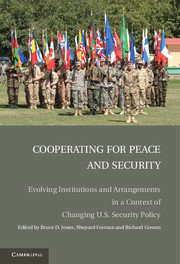 Cooperating for Peace and Security
Cooperating for Peace and Security Book contents
- Frontmatter
- Contents
- Contributors
- Foreword
- Acknowledgments
- I FRAMEWORK
- II ADAPTING COLD WAR INSTITUTIONS
- 4 An Evolving UN Security Council
- 5 Too Many Institutions? European Security Cooperation after the Cold War
- 6 Whither NATO
- 7 The Evolution of Nuclear Nonproliferation Institutions
- 8 9/11, the War on Terror, and the Evolution of Multilateral Institutions
- 9 Evolution and Innovation: Biological and Chemical Weapons
- III NEW TOOLS, NEW MECHANISMS
- IV CONCLUSIONS
- Index
- References
6 - Whither NATO
Published online by Cambridge University Press: 22 January 2010
- Frontmatter
- Contents
- Contributors
- Foreword
- Acknowledgments
- I FRAMEWORK
- II ADAPTING COLD WAR INSTITUTIONS
- 4 An Evolving UN Security Council
- 5 Too Many Institutions? European Security Cooperation after the Cold War
- 6 Whither NATO
- 7 The Evolution of Nuclear Nonproliferation Institutions
- 8 9/11, the War on Terror, and the Evolution of Multilateral Institutions
- 9 Evolution and Innovation: Biological and Chemical Weapons
- III NEW TOOLS, NEW MECHANISMS
- IV CONCLUSIONS
- Index
- References
Summary
NATO IN AFGHANISTAN: THE BEGINNING OF THE END OR THE END OF THE BEGINNING?
In October 2006 the International Security Assistance Force (ISAF) in Afghanistan – under North Atlantic Treaty Organization (NATO) command since August 2003 – assumed operational control of the whole of the country. With nearly forty thousand troops drawn from more than thirty-five countries, the Alliance was now charged with providing security and bringing stability to a deeply fractured country outside its treaty-defined area of operations. The range of tasks given to NATO forces in Afghanistan is broad and complex, from combat operations at one end to the rebuilding of roads, bridges, and schools at the other. On the face of it, the assumption of such extensive responsibilities is testimony to an extraordinary transformation on the part of the Alliance, evidence of just how far it has come from its early and initially timid forays into peacekeeping on the European continent in the early 1990s.
And yet, NATO's first operation outside the Euro-Atlantic area has proved a far greater challenge than initial planning assumptions, some of them simplistically lifted from its experiences in the Balkans, appeared to suggest. By early 2009, progress made in extending the authority of the Afghan government outside Kabul remains, at best, patchy. Critically, military operations have failed to reverse the resurgence of Taliban influence since 2002, which now extends beyond the movement's traditional strongholds in the southern provinces of Helmand, Uruzgan, and Kandahar.
- Type
- Chapter
- Information
- Cooperating for Peace and SecurityEvolving Institutions and Arrangements in a Context of Changing U.S. Security Policy, pp. 98 - 121Publisher: Cambridge University PressPrint publication year: 2009


